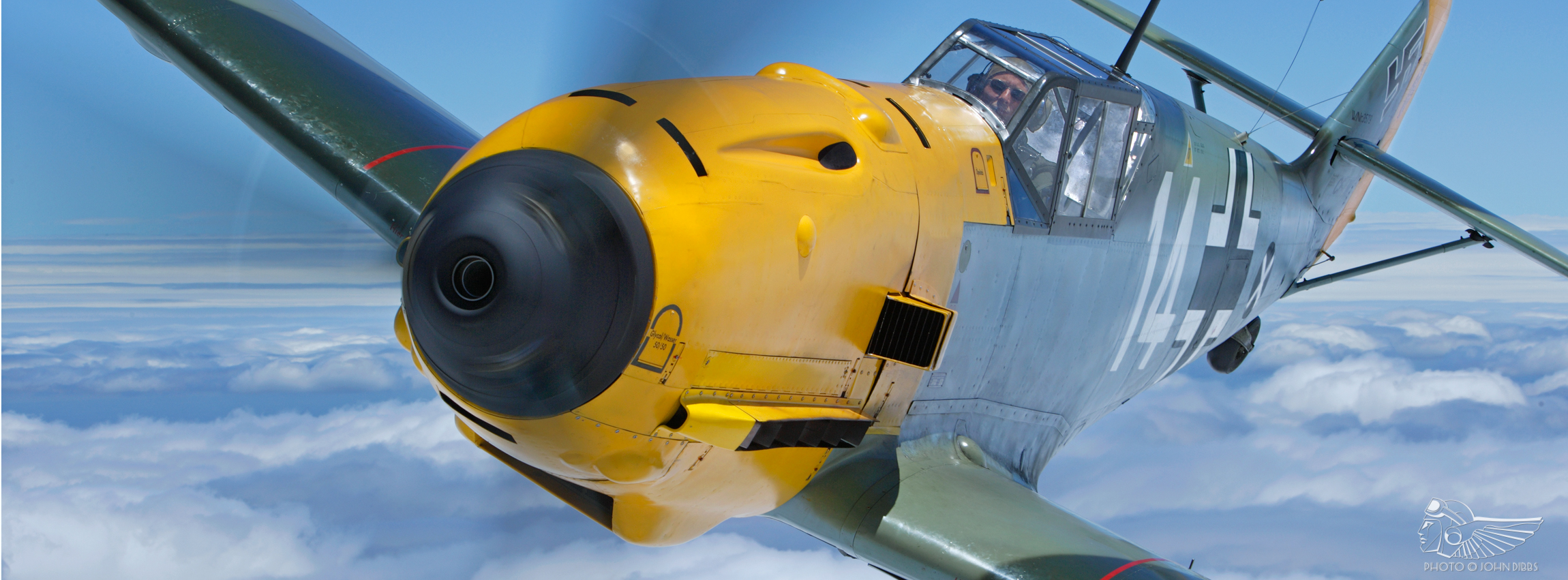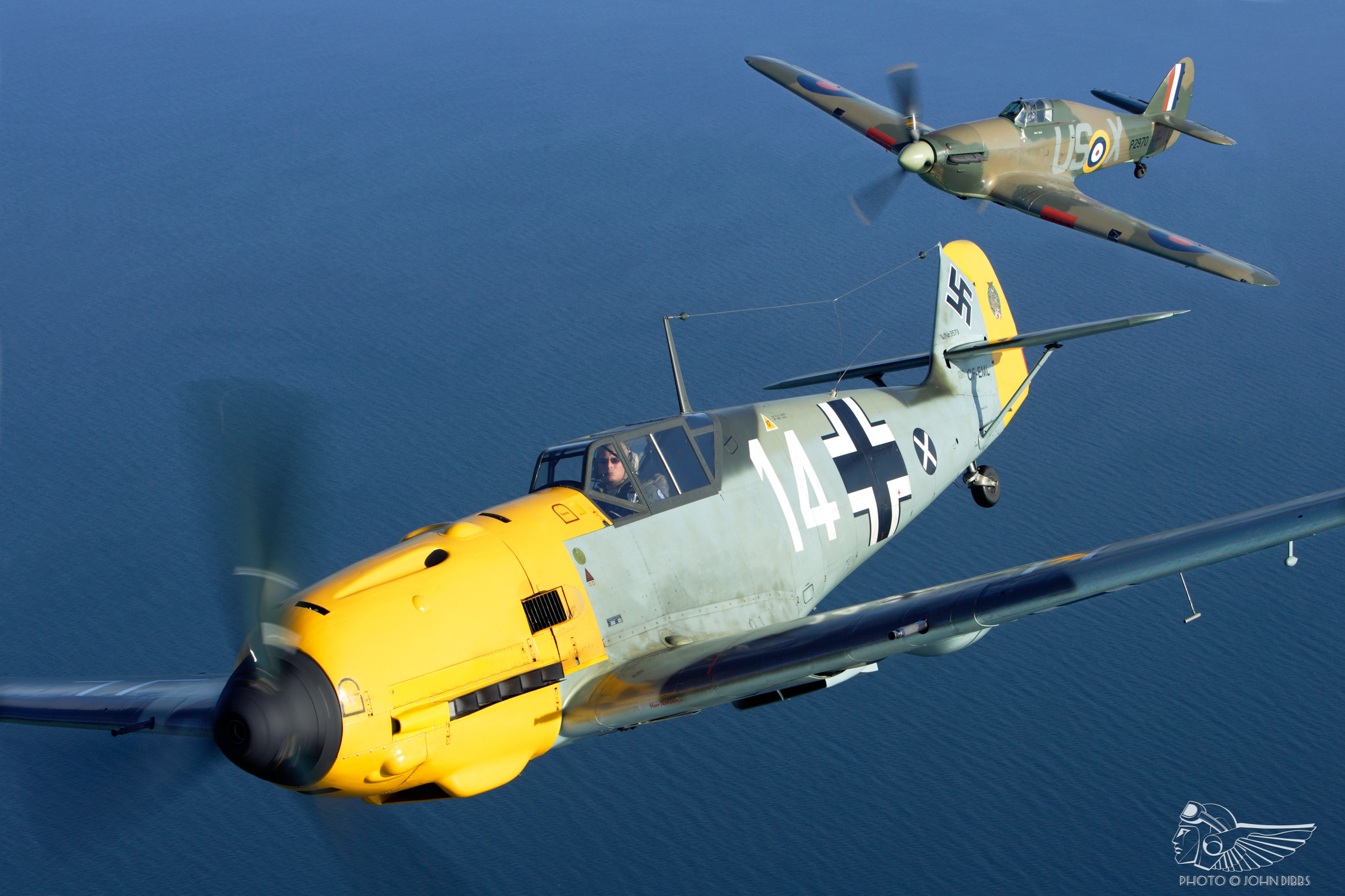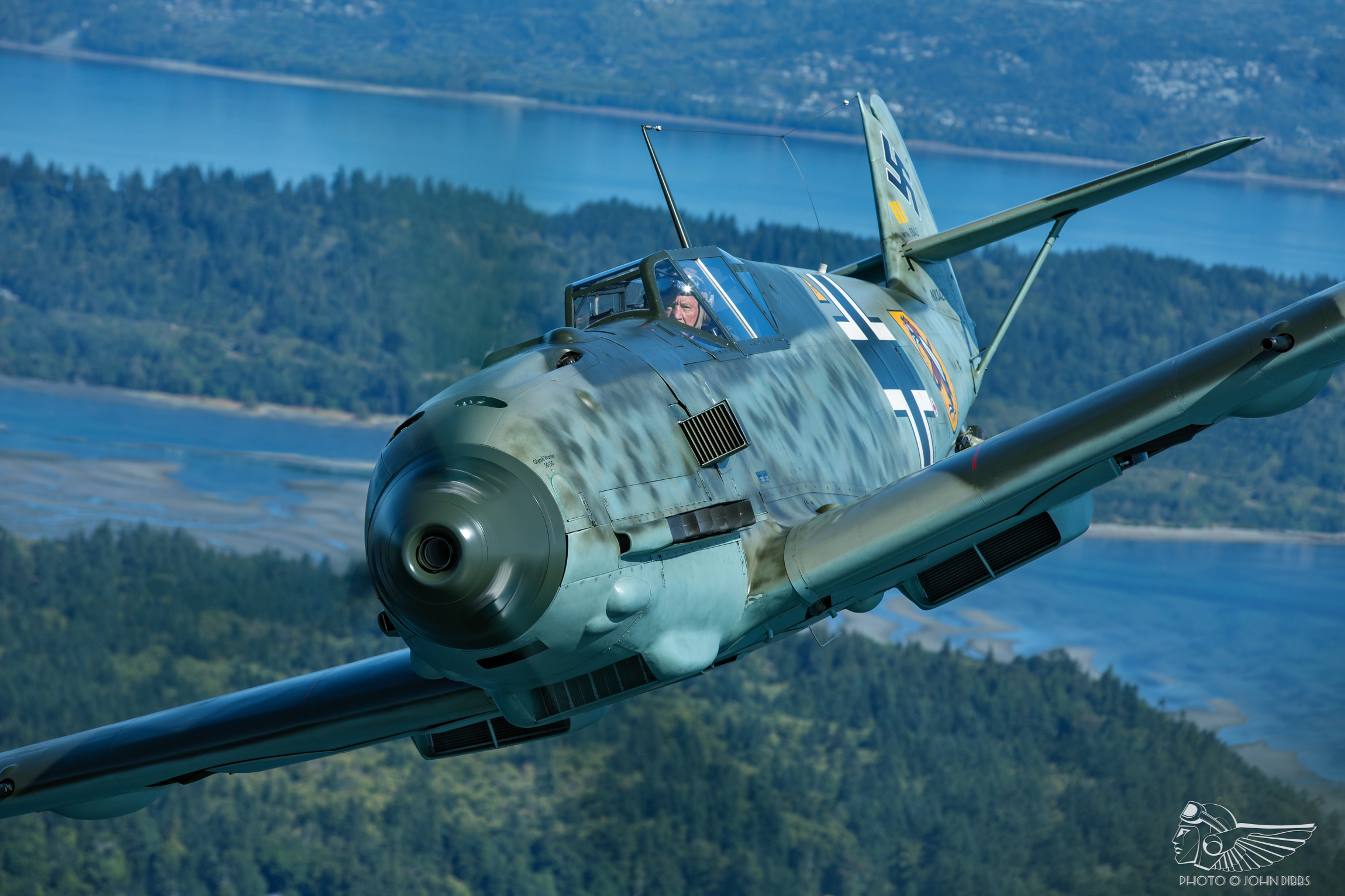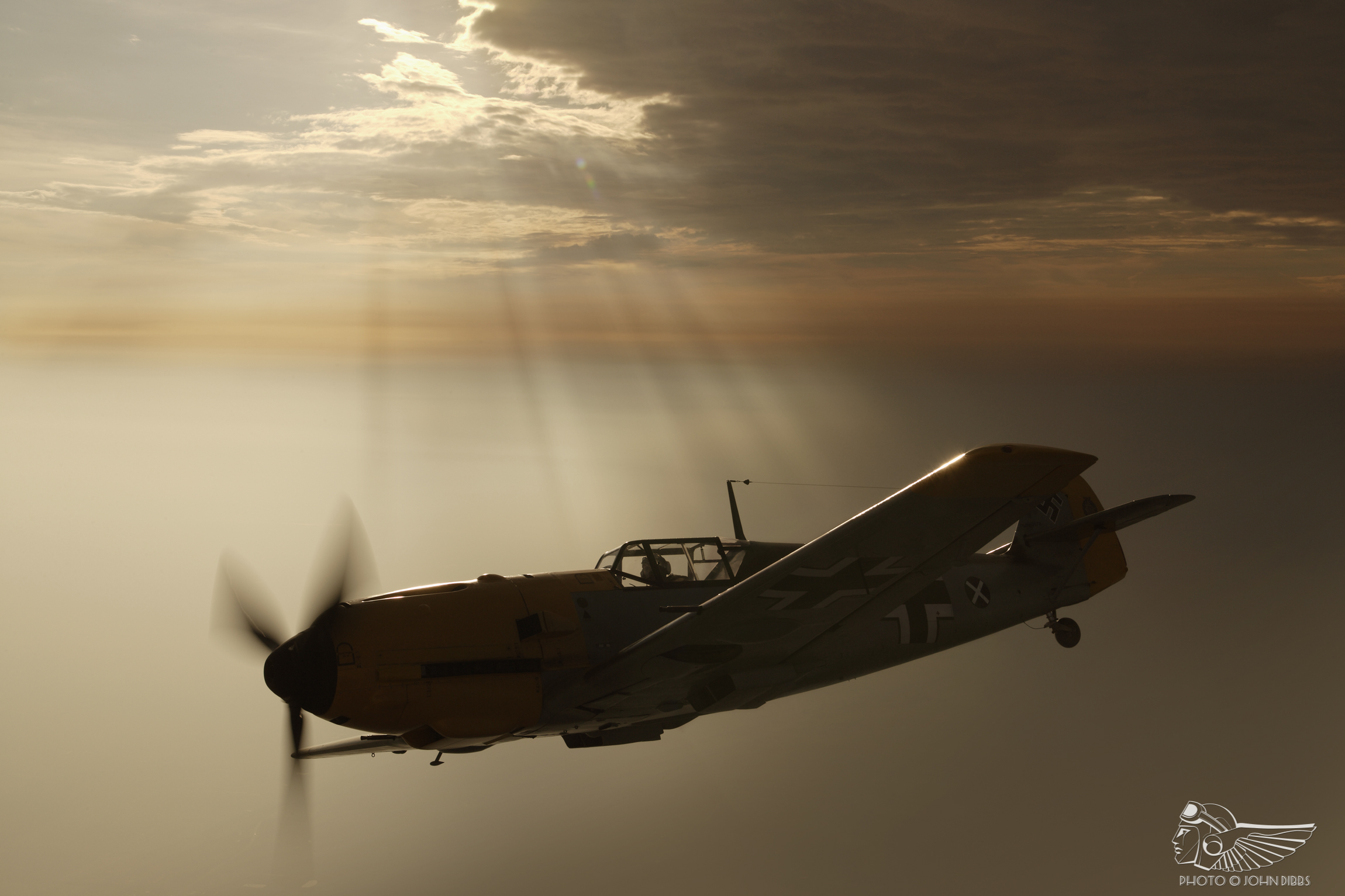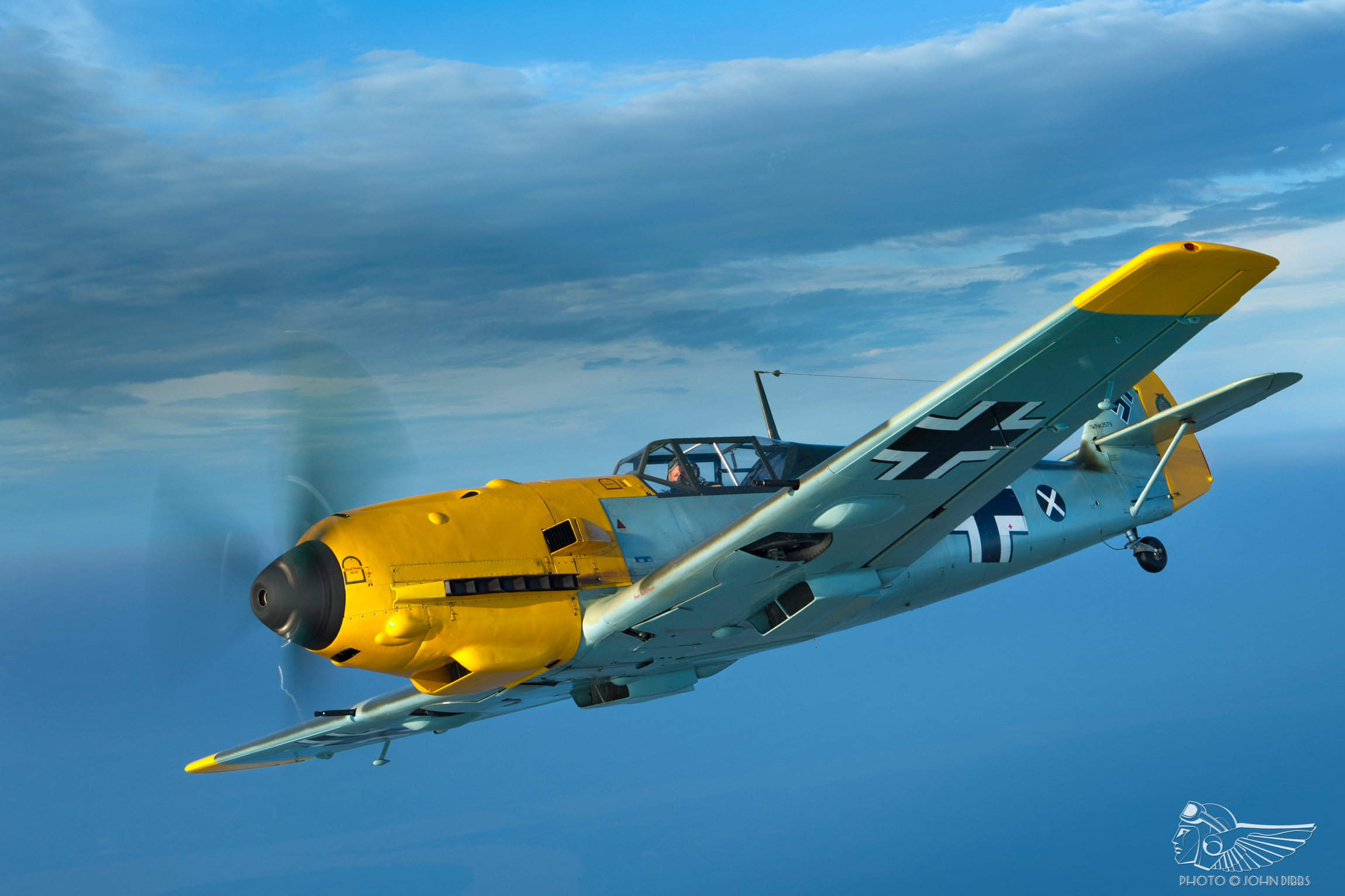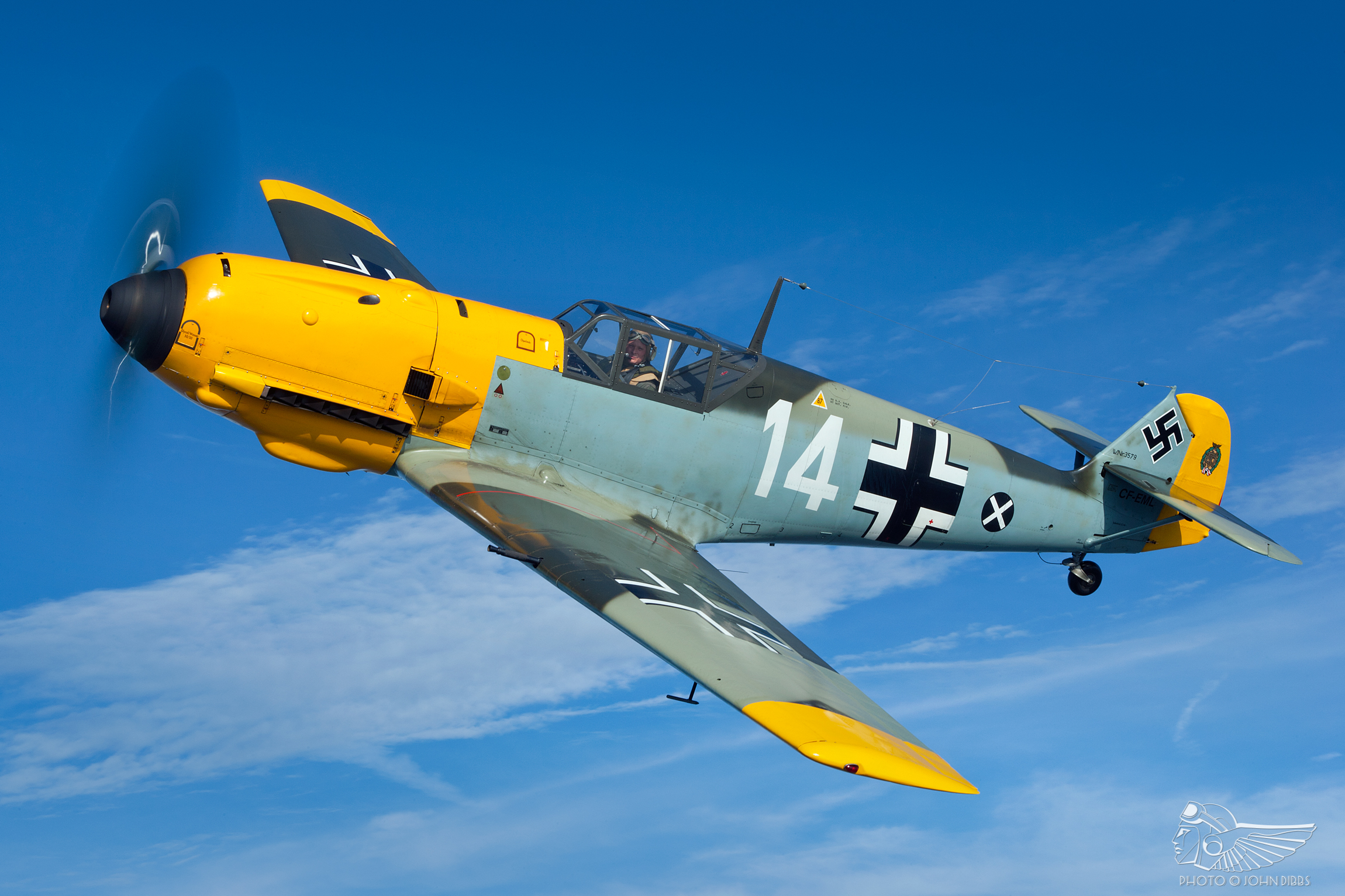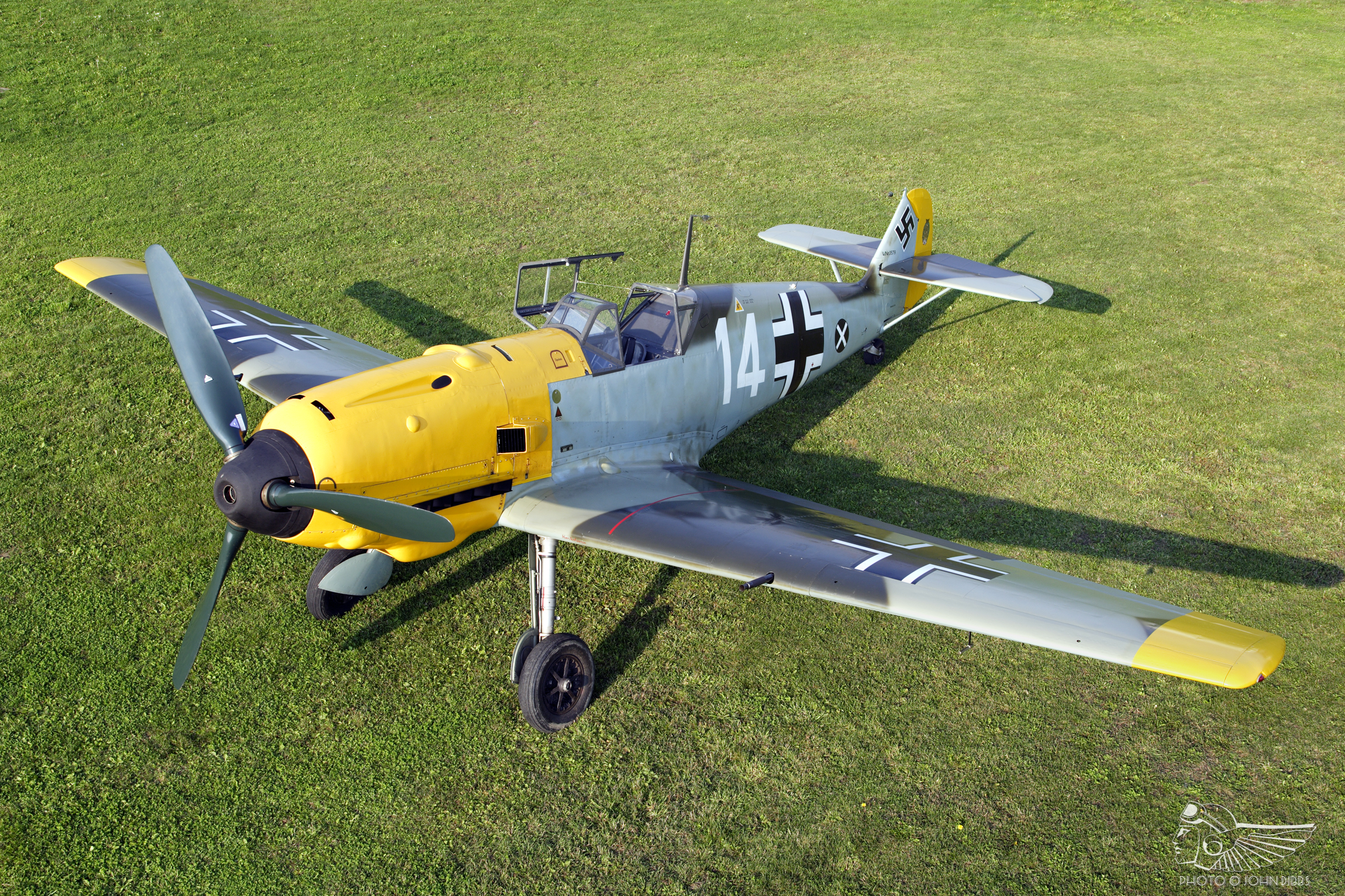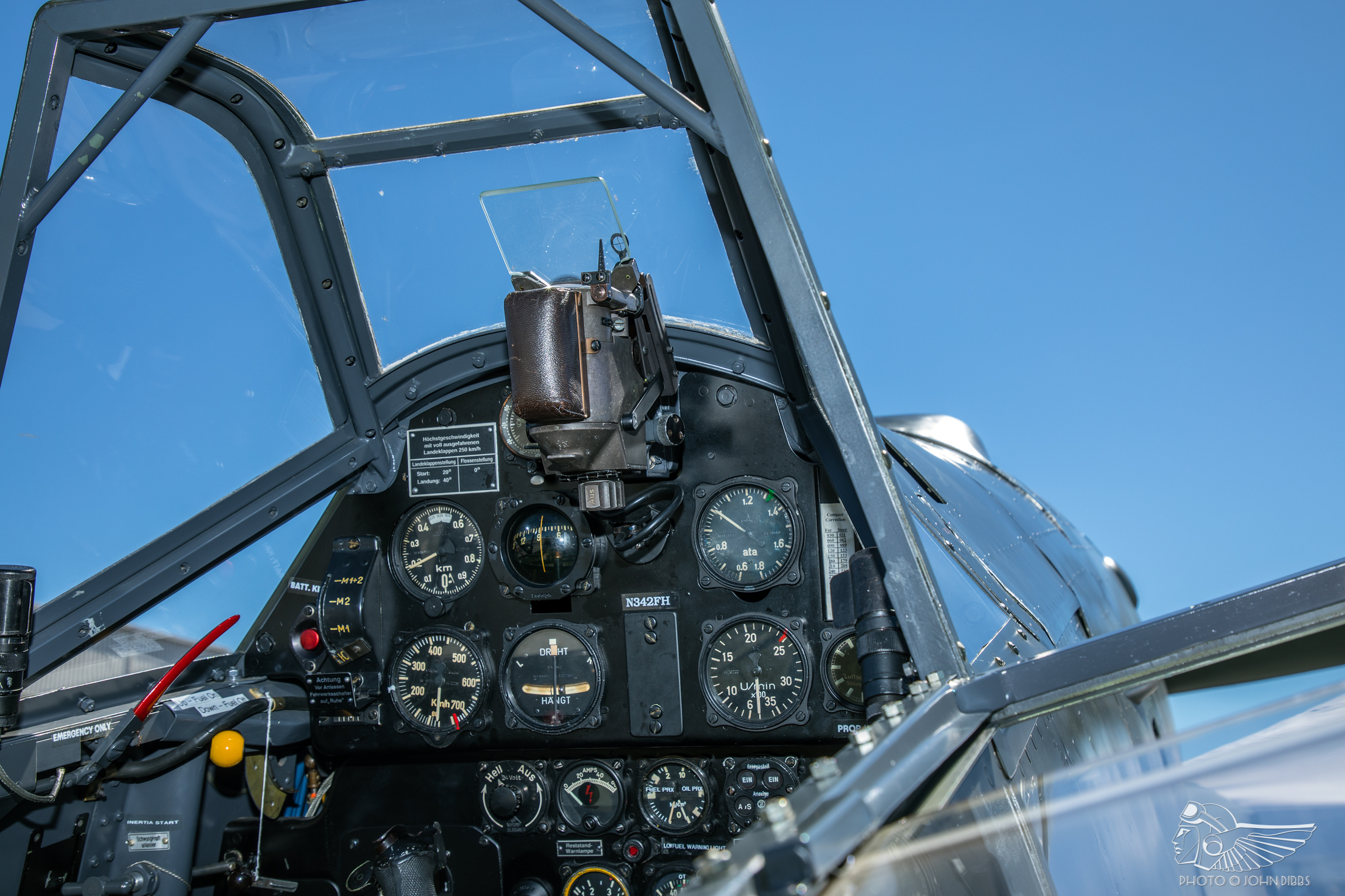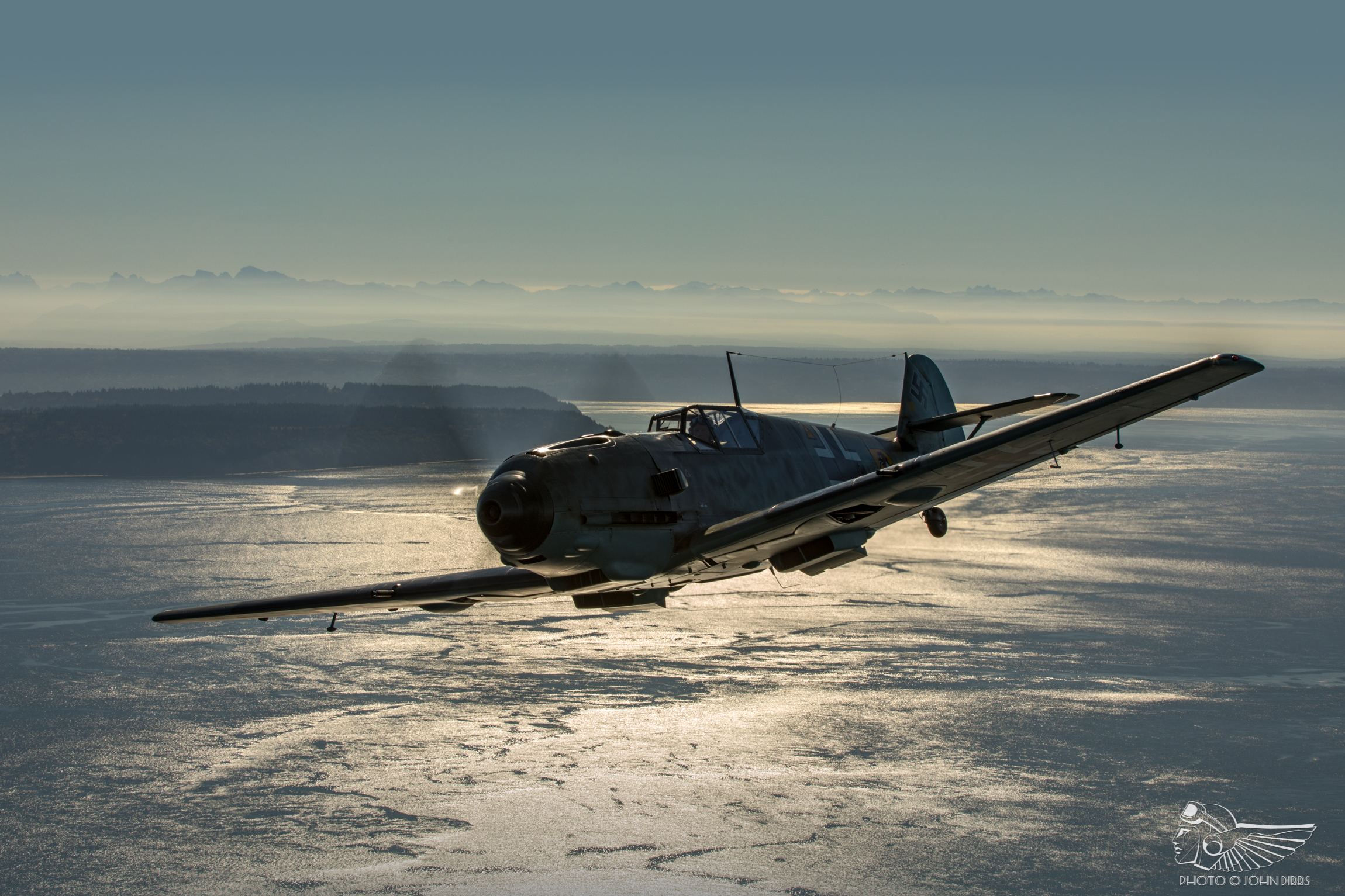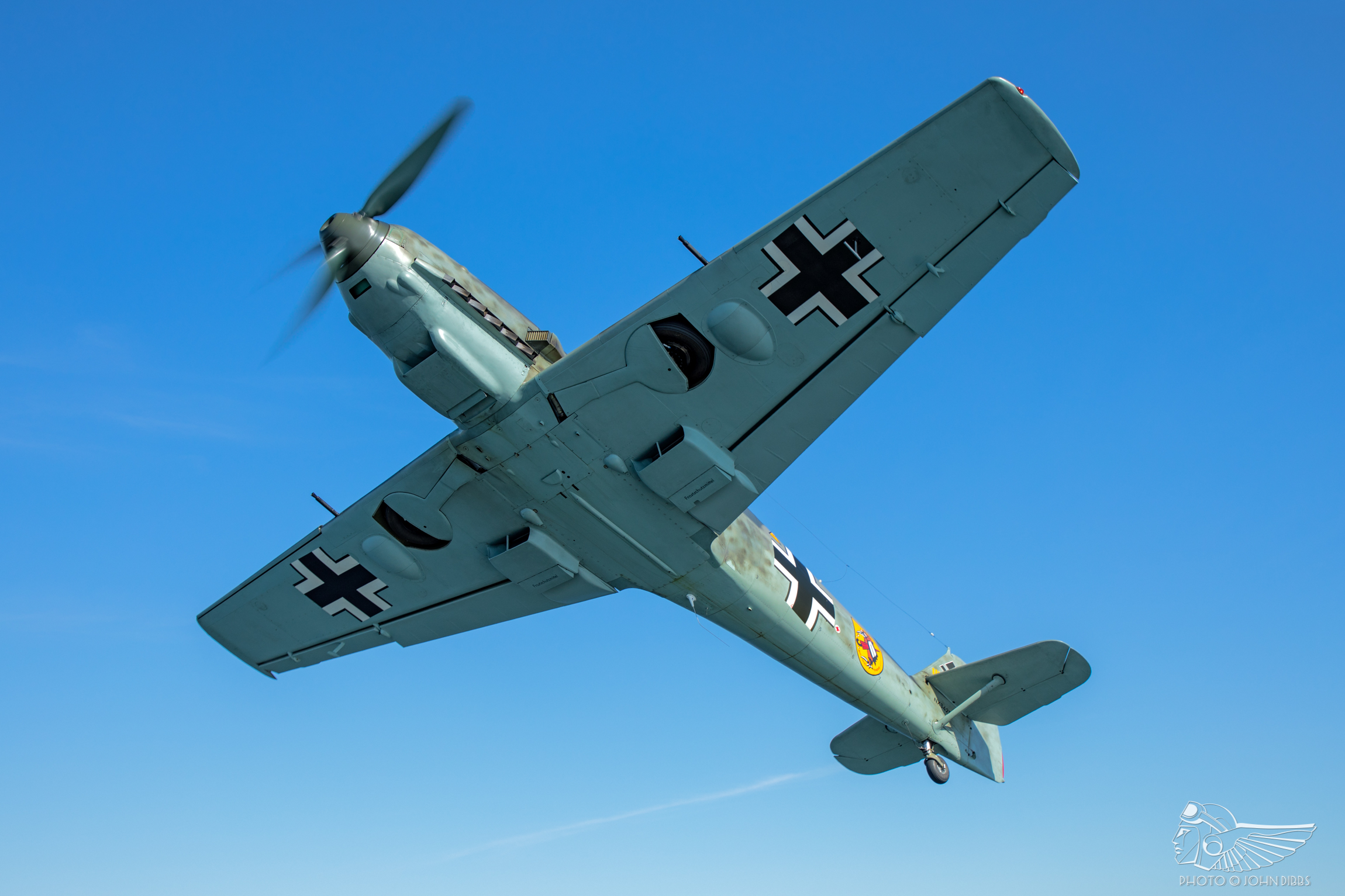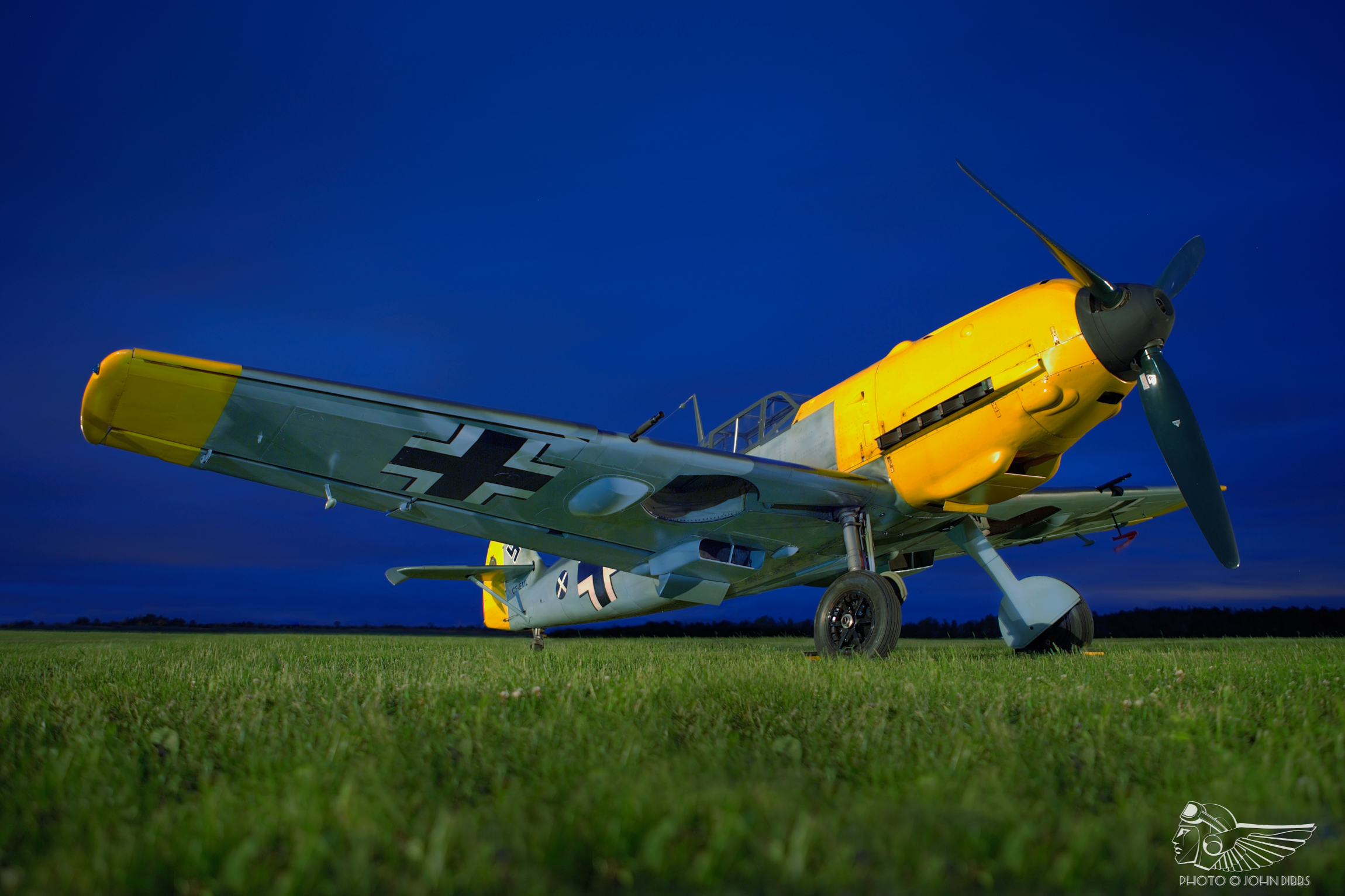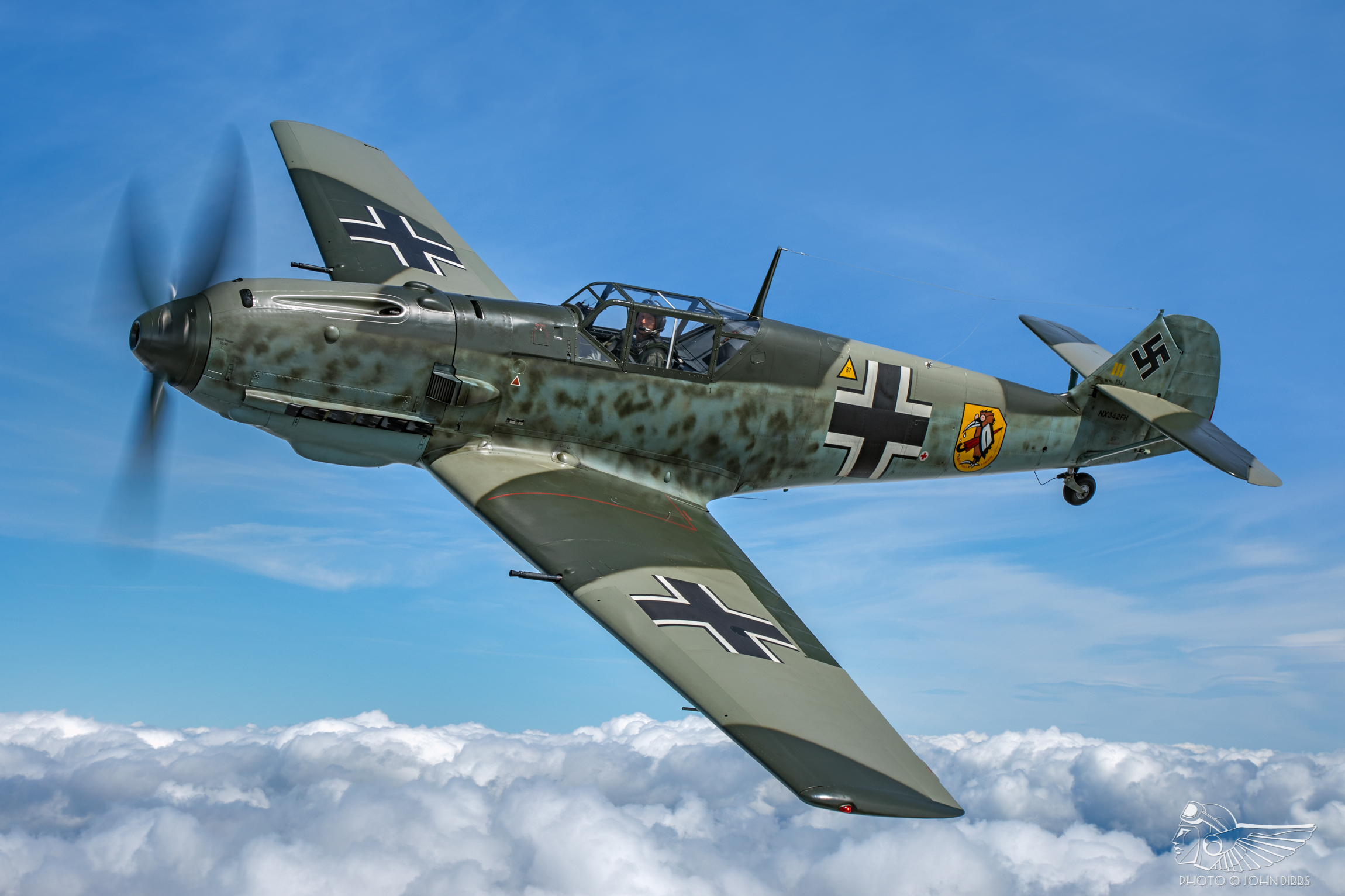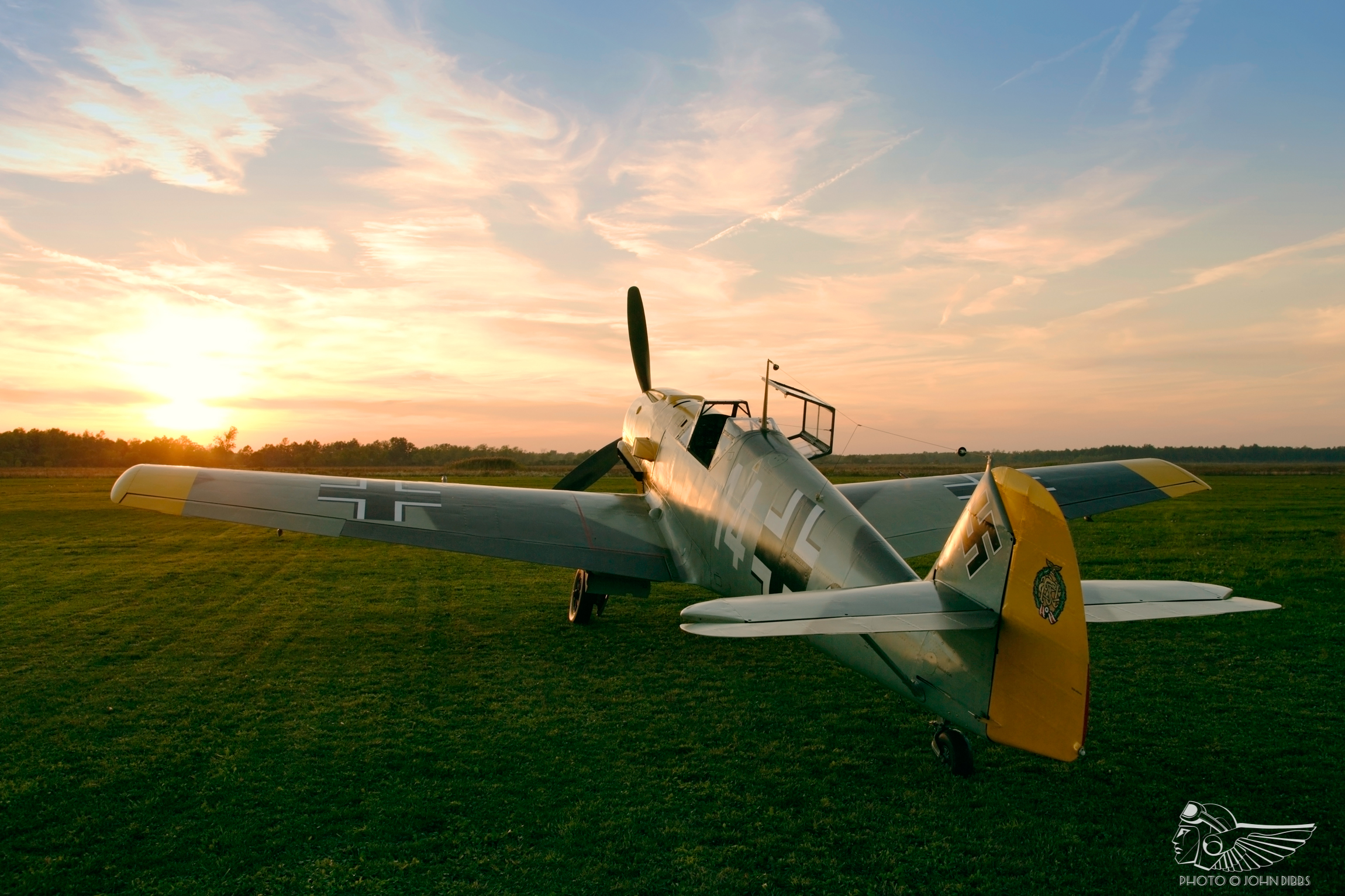“I heard all kinds of horror stories before I flew the Messerschmitt Bf 109E”, says John Romain. “I was told it always wants to ground loop, should never be flown in a crosswind, overheats very quickly, handles horribly and will lull you into a false sense of security on landing – that didn’t exactly paint a positive picture of an aircraft I had long admired!”
He is one of few pilots to accumulate extensive experience on both Bf 109s of different marks and Spanish-built Merlin-powered Buchóns, amounting to nearly 300 hours’ flying time over more than a decade. He describes the Bf 109E as one of the most rewarding vintage aeroplanes he has flown, and has approached the type from a testing and engineering background over a number of years to understand the causality of the aircraft’s many interlinked design and handling idiosyncrasies. “Some of the stories are true”, he muses, “but in many cases we have found ways to tackle those issues.” Nevertheless, John says, “You do walk out to the Bf 109E with a level of apprehension. Even with knowledge of why it behaves the way it does, there are so many stories linked with bad handling characteristics on the ground that you can’t help but approach it every time thinking, I need to be ready for this aeroplane.”
The Bf 109E sits on the ground with the coiled gait of a boxer. Its profile is tense, almost sinewy, with terrific strength built into its compact airframe. Though combat performance was broadly comparable to contemporary fighters, volatile handling characteristics cultivated a disparaging reputation that lingers to this day, and there are some alarming wartime accounts of Bf 109Es being written off in take-off and landing accidents. Almost 80 years ago, these aeroplanes were flown in combat by pilots with varying degrees of experience, operating from forward airstrips in variable weather conditions under extreme pressure. With hindsight, we can recognise factors influencing the reputation and identify how to mitigate against these in modern day operation.
John Romain was at the forefront of that movement. His introduction to the Bf 109E came in the late-1990s as he worked alongside Ed Russell to broker the deal for the Russell Aviation Group’s acquisition of rare Bf 109E-4 Wk-Nr 3579 ‘White 14’, a former 1.(J)./LG 2 machine with Battle of Britain and Eastern Front combat history, restored to flying condition in the UK before it was airfreighted to Los Angeles, CA. Reassembly at Chino, CA followed and the aircraft flew for the first time on 29 September 1999. Four years hence, ‘White 14’ was purchased by the Russell Aviation Group and exported to Niagara South Airport, Canada where it flew semi-regularly until the aircraft changed hands. It was exported once more in November 2014, this time to the UK, where it is chartered to the Biggin Hill Heritage Hangar, Kent.
Romain has now piloted both of the 1940-era Bf 109Es restored to airworthiness in the present day. Many hours of testing and air displays were flown in ‘White 14’, the opportunity allowing him to explore the aircraft’s flight envelope whilst learning the particulars of the Daimler-Benz engine. More recently, John has test flown the combat veteran Bf 109E-3 (manufactured in 1939 with Mk-Nr 1342, flown in combat by JG 51, shot down over Dover in late-July 1940, discovered on the Calais coast on 1988 and returned to flight in 22 March 2008) operated by the Flying Heritage & Combat Armor Museum (FHCAM) in Everett, WA.
Its 12-cylinder Daimler-Benz DB 601A “inverted vee” engine notably boasted direct fuel injection, the carburettor having been discarded during redesign. Two MG FF (Flug-Fest, or ‘wing-mounted’) 20mm cannon and a pair of staggered 7.9mm light machine guns gave the Bf 109E considerable armament, particularly compared to the Browning .303in (7.7mm) rifle calibre machine guns mounted in the Spitfire and Hurricane. The DB 600-series engine was manufactured to accommodate the fitment of an additional 20mm cannon in the ‘V’ between the cylinder blocks, firing through the propeller reduction gear’s hollow shaft. Numerous redesign attempts culminated in the removal of the carburettor, and the introduction of direct injection whereby 12 injection pumps spray fuel directly into the cylinders, producing the fuel/air mixture in the cylinders themselves as opposed to the carburettor, as was customary at the time. These pumps, arranged in four groups of three between the cylinder blocks, were controlled by an induction manifold pressure sensitive diaphragm, altitude pressure sensitive capsule stack and induction temperature sensitive capsule. The offshoot of direct fuel injection was improved combat performance – including the ability to push into a negative-g bunt, which the Merlin engine’s float carburettor was unable to cope with – reduced fuel consumption and the avoidance of carburettor icing.
The engine drives a three-blade controllable pitch Vereinigte Deutsche Metallwerke (VDM) propeller, operating in ‘auto’ and ‘manual’ settings sans propeller governor. In ‘auto’, manifold pressure and rpm are controlled in tandem by throttle input. The ‘manual’ setting allows the pilot to control the rpm during throttle and airspeed changes with an electric rocker switch mounted on the throttle quadrant. Manipulation of the switch adjusts the angle of the propeller blades between 22.5° and 90° (fully feathered) via an electric motor mounted on the engine crank case, with the angle of the blades indicated on a clock-like instrument in the cockpit. The DB 601A was heavier and more powerful than the Junkers Jumo engine mounted to the Bf 109D, necessitating a comprehensive redesign of the airframe. The D model’s nose-mounted radiator would have added further weight and drag to the airframe, nullifying the Daimler-Benz engine’s additional power, and the radiator was accordingly relocated under wing (the twin radiators counterbalancing the substantive combined weight of the DB 601 and VDM propeller), with the oil cooler occupying a streamlined duct beneath the nose. The Bf 109E’s wing structure was also modified as a result of the new engine, with several inboard ribs aft of the spar cut down to accommodate the radiator ducting. The redesigned structure gave the wings tremendous strength. High loading was offset by the short, square-tipped cantilever wings, each containing roughly half-span leading edge slats, aerodynamically and inertially actuated to increase the size of the wing, channel airflow over the upper wing surface and maintain airfoil effectiveness.
The main gear legs are attached to the base of the fuselage aft of the firewall to allow easy disassembly and transport, and are splayed forward and outward with tyres mounted “crooked” on the gear legs at an inward-facing camber of around 25°. If the aircraft taxies with an equal download on both main undercarriage wheels, the forces remain symmetrical and the aircraft rolls straight ahead. Break that symmetry by exerting greater force on one undercarriage leg (for example, centrifugal forces produced on take-off) and the corresponding tyre will ‘bite’ into the ground and create directional instability as the wheel attempts to turn inwards. Directional changes created by torque, rudder input, crosswind or even poor runway conditions can force the aircraft into a severe ground loop, potentially at high-speed on take-off or landing where the gyroscopic forces are more pronounced. To mitigate against this, common practice with Bf 109s and Buchóns is to overcharge the pressure on the left oleo to the equivalent of 100 psi. That, John says, “Reduces the ‘give’ on the left leg on take-off and landing. On the Battle of Britain film, the Spanish pilots would taxi back if they had a soft left leg. It’s a learned technique, and thank goodness there are people who have experienced it and have done that themselves – it’s nice not to have to go through a steep learning curve before you learn it yourself”.
Uniquely for a V12 engine, the “inverted vee” design of the DB 600 series causes oiling issues in the lowermost engine components, requiring considerably more preventive maintenance than contemporary power plants such as the Rolls-Royce Merlin. If the Bf 109E has sat idly on the ground for some time, oil will have dissipated into the cylinder heads and a hydraulic lock on start-up, whereby the piston hits oil settled in the cylinder, may be symptomatic and can inflict long-term damage on the engine. To mitigate against this, pre-flight preparation includes removing the plugs at the end of the induction tubing and turning the propeller through by hand to drain oil from the system. The altitude pressure-sensitive capsule stacks within the fuel injection pumps will also be drained of oil to avoid impairing capsule movement. Oil is likely to have coated the spark plugs (of which there are two per cylinder), and these will be removed and cleaned in advance of an engine run to prevent a mag drop. On the day of the sortie, the total-loss oil supply system of the fuel injector unit will be topped up with around a quarter of a litre of oil.
A scan of the matte black cockpit panel suggests a considerate, utilitarian approach, with magnetos and flying instrumentation positioned directly in front and to the left of the pilot, engine instrumentation to the right and temperature, pressure and fuel gauges laid out neatly beneath – a far cry from the more scattershot approach of British cockpits. Manifold pressure (MAP) is measured in atmospheres, marked as ‘ATA’ on the MAP gauge and indicated in tenths of an atmosphere, from 0.6 to 1.8 ATA, with 1 ATA equating to 0psi boost or 30in Hg. Airspeed is measured in kilometres per hour (km/h) and the altimeter is in metres. A quadrant to the pilot’s left contains the throttle lever and electric propeller control. Radiator doors, flaps and trim are all manual systems operated by hand via series of levers and wheels. Only the primer, tucked alongside the pilot’s right thigh beside the seat, can be considered to be a little ‘out of the way’. The canopy framing is light and thin, a world away from the heavy grade steel structure of the later model Bf 109s and Buchóns. Visibility is described as excellent, albeit the view forward is impaired by the long nose and cowling fairings. “You don’t get that ‘locked in a coffin’ feel with the E model”, John remarks. “It’s more of a greenhouse-type feeling with plenty of ambient light and few obstructions.”
Start-up is uncomplicated. The electrical mains are switched on, fuel tanks selected and a manual wobble pump used to build fuel pressure up to 0.5 kg/cm² before the fuel pump is activated. Up to ten primer strokes inject a fuel/oil mixture directly into the engine from a small capacity primer tank that sits independently to the main fuel cell. The throttle is cracked by ¾ of an inch and the radiator doors are cranked fully open – coolant temperature rises quickly on the ground, albeit not to the extent of an early Spitfire. The rocker switch on the throttle quadrant is then used to adjust the propeller blade angle to 12:00 (full fine) on the “clock” for start-up with the propeller in ‘manual’. Restored Bf 109Es flying today are fitted with electric starters, replacing the wartime hand cranks used by ground crews to manually wind up the starter flywheel. Accordingly, the starting handle is pulled to engage the flywheel to the engine, and the magnetos selected on as the engine fires. Oil pressure is an immediate concern, and this will often sit high outside its green range if the aircraft has been started “cold”; as oil and engine temperatures increase, pressure will gradually lower into the normal range as the oil thins. With the engine ticking over at 800 rpm on idle power, oil and coolant temperatures of 40°C and 60°C respectively are desired, and the throttle is advanced to 1200 rpm for the warm-up.
The centre of gravity sits aft of the Bf 109E’s main undercarriage, and ground handling calls for a combination of power, forward stick, full rudder and braking to unload the castering tail wheel and move the aeroplane; the same technique would put a Spitfire on its nose. A quick tap of the brakes as the aircraft moves off will identify the need for adjustments (not uncommon in the Bf 109E), and some gentle weaves should illustrate any loss of pressure in the oleos. Pre-take-off checks see the pilot set the propeller blade angle to 11:45 and run up to 1750 rpm for sequential magneto and propeller checks, with coolant temperature rising to 90-100°C and oil temperature to around 50°C prior to take-off. If the engine has sat at idle power for a prolonged period, the pilot can engage a spark plug cleaner to produce a momentary ‘hot burn’ to clear excess oil off the spark plugs (preventing a potential mag drop), which reduces rpm for up to 20 seconds before full performance is restored. Grass runways are the preference for departure, and it’s essential to roll the aircraft onto the runway centreline at a walking pace to straighten and then lock the tail wheel using the mechanism mounted to the left canopy rail; this prevents free castering during the take-off, and makes the aircraft eminently more controllable at the most critical part of the sortie.
“Before I flew the Bf 109E, I had the opportunity to sit down with Oscar Bösch, ex-Luftwaffe fighter pilot with over 600 sorties in 109s”, John remembers. “One of his tips was to slowly increase the power and let the tail come up of its own accord, to avoid putting too much pressure on the undercarriage. His view was not to fight it, and to let the aircraft fly itself off the ground in a tail-low attitude.” This approach was shared by Buchón connoisseur Connie Edwards. “I had visited Connie’s farm many years ago, and we talked Buchóns over a few beers. He was of the opinion that Buchóns were far better than Spitfires, and it was one of his favourite aeroplanes. His ground rules were to give plenty of power on take-off, keep the stick over to the right and don’t be too eager to coax it off the ground. I kept this advice in mind the first time I flew the Bf 109E, and it served me well.”
With full right aileron and neutral elevator pitch, power is fed incrementally to take-off boost of 1.4 ATA. “Bring in the power in gently, allow the aircraft to come alive and make small adjustments with the rudder to maintain positioning”, John says. “As the tail begins to come up of its own accord at around 60km/hr, you become aware of the geometry of the undercarriage, and you’re into what is potentially the most dangerous part of the flight.” The gyroscopic forces exerted on the aeroplane as the throttle is opened produce a significant amount of yaw, and compress the left oleo to the extent that the pilot will experience a pronounced left wing drop. That, John says, can be disconcerting for a pilot unfamiliar with the Bf 109E’s handling characteristics: “If you apply too much power, the left wheel will bite into the ground and the aircraft diverges to the right because of the camber. You might start thinking you’ve overcompensated with counteracting rudder, so you relax the pressure on the rudder pedals – that in turn aggravates the torque and the aircraft yaws heavily to the left. You can easily get yourself into a situation where you have induced enough oscillation for the aircraft to depart the side of the runway in a high-speed ground loop. The geometry can really upset your thought process”.
Dampening rudder input, accepting a few degrees of deviation and allowing the aircraft to settle in a tail-down attitude to keep the pressure off the main undercarriage will mitigate against pilot-induced oscillations. “The only thing to do is to back off on the power and let the aeroplane settle. Once the airspeed has increased and it’s calmed down a little, advance the throttle and let the aircraft fly itself off the ground. Knowing what the aircraft is doing and why will ensure that you don’t get yourself into what could be a fatal situation.” Once airborne at around 110 km/hr, select the brakes on then off, retract the gear using the T-handle on the instrument panel and coarsen the propeller to avoid rpm overspeeding as the airspeed increases to 250 km/hr in the climb. To prevent overheating at climb power of 1.4 ATA and 2400 rpm, the radiator doors are cranked up half-way to stabilise coolant temperature before settling into the cruise at 0.6 ATA/1600 rpm (with the propeller set to 10:30 on the clock). Typically, the radiator is left in that half-open position for the majority of the flight and the coolant should sit quite comfortably in the 90°C region.
“When I started flying the E model in Canada, there were a lot of stories about oil temperatures hitting the redline”, recalls John. “It became clear once I had made a couple of flights in the aircraft that other pilots had seen the oil temp rising and had fully opened the radiator doors. The Bf 109E does run with hot oil temps compared to other aircraft and the temptation on seeing that is to fully open the doors. All that does is increase the drag and the engine is then working harder – coolant temperature will drop, but oil temperature will actually increase as a result. The best course is to bring the power back, keep the airspeed up, keep the drag as low as possible and you’ll see that oil temperature start to decrease.” With its manual systems, German instrumentation and well-documented vices, the Bf 109E demands a high workload from the pilot. “You know you’re flying an aeroplane with quite a delicate engine, and that is a real handful on take-off and landing”, says John. “You’re very conscious of that before and during any flight.” Sympathetic engine management translates in-flight to conservative power settings and gentle power changes. “It’s a powerful, big bore engine that needs a lot of care – it’s a reliable and reassuring engine, but you certainly wouldn’t consider opening or closing throttles rapidly as it wouldn’t cope with rapid momentum changes and high acceleration or deceleration will only shorten its life.”
Performance is by no means dissimilar to contemporary fighters, though in some arenas the Bf 109E exhibits demanding handling characteristics with a number of notable peculiarities. The stall is generally benign and forgiving in both ‘clean’ and landing configurations, with a pronounced buffet below 110 km/hr followed by a light pitch and wing drop. The aeroplane is cleared for standard aerobatic figures and comfortably flies loops, half-Cubans, barrel rolls and aileron rolls. Light and responsive ailerons give the Bf 109E what John describes as a phenomenal rate of roll, particularly below 400 km/hr, to the extent that, “You feel you could roll it on the climb-out from take-off”. Well-harmonised controls make flying barrel rolls a delight, and light pressure on the rudder pedals will keep the aircraft in balance during any rolling manoeuvres. Holding the aircraft inverted and pushing the stick forward to induce negative-g sees no change in engine performance. Conservative power settings of 1.3 ATA and 2400 rpm and a minimum of 450 km/hr are sufficient for vertical aerobatics, but Romain identifies that there are ground rules to adhere to. Airspeed and energy decay rapidly in the ascent due to the high wing loading and drag from the under wing radiators, and unlike the Spitfire and Buchón, successive looping manoeuvres are not possible; in the air display environment, expect to see a marked loss in energy after a single Cuban-eight. With minimal pressure on the stick, the aircraft will fly itself over the apex of a loop at 200 km/hr and 1.5-2g with a gentle slat deployment as the aircraft approaches the stall.
“With the propeller set to ‘manual’, you could adjust the blade pitch to achieve a top end of 2400 rpm for aerobatics and you would know that the rpm won’t exceed that,” John adds. Doing so would likely see the propeller slow to 1200 rpm at the apex of a loop or half-Cuban, reducing yaw as the aircraft pitches into the vertical. “You can do a lot with that propeller to improve performance, if you know how to use it. Though you have the ability to fine off the prop at the top of a vertical manouevre to increase or maintain rpm, you’re adding to your own workload and you’re going to see the rpm going through the redline on the dive if you don’t coarsen the blades on the descent. It’s much better to set the maximum rpm before beginning aerobatics and leave it there.” The Bf 109E’s propeller pitch control was a source of consternation among some Jagdwaffe pilots; those who used the controllable propeller pitch to their favour enjoyed a marked advantage over their RAF counterparts when facing Spitfires equipped with the early two-stage propeller. For less experienced pilots, however, the ‘manual’ system could be burdensome. Oberleutnant Ulrich Steinhilper of III./JG 52 recounted one such incident as his flight of Bf 109Es crossed the French coastline: “It was obvious that [the pilot] wasn’t manipulating the pitch control with the skill of the more seasoned pilots to produce the same power as our machines. We tried to tell him what to do on the radio, but to no avail”1. Half-way across the English Channel, the young pilot was ordered to leave the formation and return to base. Leutnant Erich Bodendiek, II./JG 53, was equally disparaging of the Bf 109E’s automatic propeller setting, describing the aircraft as “un-manoeuvrable… swaggering through the air like a pregnant duck” 2.
Considerable stick forces are felt during high-g turns and aerobatics and John cautions that, “You’ll need a two-handed pull to recover from tight figures. If you’re below 500 ft with the nose pointed at the ground, the stick forces are significant and can catch out a new pilot”. This point wasn’t lost on RAF Fighter Command pilots in 1940, and there are written accounts of Bf 109Es being lost through their inability to match a Spitfire or Hurricane in a diving pull. Flt Sgt Phillip Tew of No. 54 Squadron was one such pilot who brought about the destruction of a Bf 109 without firing a single shot. He wrote in his combat report: “Enemy aircraft half-rolled and followed me. I pulled out of dive at low altitude but enemy aircraft continued his dive and struck the ground and burst into flames”. New Zealander Al Deere fought the E model over Dunkirk, learning that, “The best counter was to go into a right turn. The Spitfire was infinitely superior to the Messerschmitt, and so long as one remained in the turn, the enemy pilot could not bring his guns to bear. The rest was easy” 3. Experiences in northern France informed how RAF pilots engaged the Bf 109E during the Battle of Britain. Jeffrey Quill reflected that, “The Spitfire had the edge over [the Bf 109E] in speed and climb, and particularly in turning circle” 4. In one engagement over the English Channel, Quill’s flight of Spitfires was ‘bounced’ by 109s. Taking evasive action, he found himself behind two Messerschmitts in a steep left-hand turn. “I was able to turn inside the second one and fired at him from close range. He went on pulling round as sharply as he could. I followed him without any difficulty and went on firing bursts at him. I was now convinced that the Spitfire Mk.I could readily out-turn the 109… probably at all heights.”
Judicious rudder input is needed in high-speed pitching and turning figures to keep the aircraft in balance, with a degree of corrective rudder is required throughout looping figures. “The aircraft is directionally unstable and there’s no rudder trim, so you’re constantly working your feet to apply and adapt pressure on the rudder pedals at all stages of flight to keep the slip ball in the middle and effectively keep that rudder in trim”, continues Romain. In a hard pitching turn, the pilot should be prepared for more marked deployment of the leading edge slats and aileron snatching. Though uncommon, it’s possible that a combination of imbalance, rudder input and asymmetric slat deployment could induce a serious directional deviation during vertical aerobatics, and there are accounts of Bf 109Es recovering from loops offset to the direction of entry – the key, as with much of the E model’s handling, is to avoid overcompensating on the control inputs and keep a vigilant eye on the turn and slip indicator. “The slats can be quite violent when they deploy under high g loading”, John adds, “and you’ll feel the thud through the airframe. If there is any yaw, the slats will deploy asymmetrically and you’ll experience a sharp oscillation because one wing will have more lift than the other”.
This trait caught out many a young Luftwaffe pilot during the air battles of 1940 as they pushed their aircraft to the edges of its performance envelope. RAF ‘Ace’ George ‘Grumpy’ Unwin recounted that he, “Had survived… simply because the Spitfire could sustain a continuous rate of turn inside the Bf 109E without stalling” , owing to its lower wing loading, and said that, “The latter was known for flicking into a vicious stall spin without prior warning if pulled too tightly”. No. 92 Squadron’s Geoffrey Wellum remembered seeing a Bf 109E tightening its turn to the point of departure. His tactic was to hold his Spitfire in a pre-stall buffet until the 109 could no longer maintain the turn. “You won’t do it, mate,” he wrote after one intense engagement, “we’re on the limit as it is” 5. Brian Lane, of Duxford’s No. 19 Squadron, fought to a stand-off with a Bf 109E on 15 September 1940 and experienced first-hand the E’s potential limitations. “I have never seen [a Bf 109E] thrown about as that one was… he continued to lead me on a hell of a dance” 6. He recalled, “First one wing and then the other would dip violently” as he engaged the German, until, “He suddenly flung out of the turn and rolled right over on his back… giving me the chance to get in a good burst”. The Bf 109’s inability to match the Spitfire in the turn was well documented by the Jagdwaffe. “There seems to be no way of nailing them”, wrote Heinz Knoke of II./JG 52. “[They] can make such infernally tight turns.” 7. Günther Rall served with III./JG 52 during the Battle of Britain. He reflected latterly that, “I didn’t like the slats… We couldn’t catch [Spitfires] in a steep climb. They were a highly respected enemy” 8.
In the hands of the Jagdwaffe’s Experten fighter aces, the Bf 109E’s idiosyncrasies could be exploited to the pilot’s advantage and the aircraft gave a terrific account of itself during the opening months of the war. Some 80% of the 2000 Jagdwaffe sorties from late May to early June 1940 were flown by Bf 109Es, and more than 50 Jagdwaffe pilots were credited with five victories or more during the air war of the Battle of France as the Bf 109Es leapfrogged across the continent to provide air cover for the advancing German ground forces; 26-year old Wilhelm Balthasar of 1./JG 1 was the most successful of these, claiming 23 victories during the campaign (amongst them Gladiators, Lysander, Blenheim, Hawk 75, Hurricanes and Spitfires), including nine over the course of two days. Though limited in its combat endurance, the Bf 109E continued to be a formidable adversary for RAF pilots throughout the Battle of Britain. Oberleutnant Erwin Leykauf had 33 victories to his name, three of his five ‘kills’ in 1940 being Spitfires. He disputed the assessment of the Bf 109E as an inferior turning aircraft to its RAF counterpart, citing technique as the key to success: “It is possible to find pilots from that period who will tell you that the Spitfire turned better than the Bf 109. That is not true. I myself had many dogfights with Spitfires and I could always out-turn them. One had to enter the turn correctly, then open up the engine. It was a matter of feel. When one noticed the speed becoming critical – the aircraft vibrated – one had to ease up a bit, then pull back again, so that in plan the best turn would have looked like an egg or a horizontal ellipse rather than a circle. In this way one could out-turn the Spitfire.”9
“Undoubtedly, the 109 in the hands of a good pilot was a tough nut to crack” 10, summarised Al Deere. “The Spitfire could out-turn, but it was at a disadvantage in manoeuvres that entailed negative-g forces. Overall there was little to choose between the two fighters.” Hugh Dundas agreed that, “The Messerschmitt 109 and the Spitfire were extraordinarily evenly matched. But on balance the Spitfire was, I believe, slightly the better aircraft. And so it was in 1940. In particular, such advantages as it enjoyed over the ME 109 [sic] at the time were enhanced by the circumstances of the battle” 11. Romain adds that, “Reading RAF combat reports, you can see that the 109E’s quirks could lead to its downfall. If it was pulling hard at low-level, the RAF pilots would see the slats deploy and it could violently roll the aircraft into or out of a manouevre, which could be fatal in a combat situation. We know how to fly these aircraft sympathetically and anticipate that, but Luftwaffe pilots didn’t have that luxury – it’s interesting to see how our own experiences compare.”
Rejoining the circuit for landing, the power is brought back to 0.6 ATA on the base leg, radiator doors cranked fully open and the fuel feeder pump activated. As the airspeed decreases below the gear limit of 210 km/hr, the undercarriage and flaps are lowered as the pilot turns in for a steep curving approach – considerably steeper than the Spitfire which, by contrast to the Bf 109E’s reputation, was considered by the Luftwaffe airmen who flew it to be “childishly easy” to land. With the elevator trim and flap cranking wheels positioned side-by-side, the pilot can rather ingeniously feed in flap and counteracting elevator trim simultaneously, reducing workload during a critical part of a sortie. The propeller pitch is set to the 11:45 position for landing so as to improve responsiveness without inducing excess drag on the approach. The final degrees of flap are brought in as the aircraft turns final, and a quick scan of the instrumentation and systems checks the vitals – brakes, propeller, radiator, gear and flaps – before committing to the landing.
Contrary to popular belief, John asserts that the Bf 109E handles excellently in a crosswind and has operated the aircraft with a 22 mph side-wind with no issue. It will show no ill-effects in a quartering tail wind, the likes of which could easily run a Spitfire pilot into trouble, thanks to the aircraft’s weight and aft centre of gravity – indeed, John recalls landing a Buchón at Tempelhof, Berlin in such conditions during the filming of Valkyrie. “Arriving over Berlin with two 109s in Berlin defence markings and two Ju 52s on a wet, murky evening, I couldn’t help but think, my god, this is pretty spooky”, he remembers. “Walter Eichorn was leading in a Bf 109G. I called him up and queried landing with a quartering tail wind. ‘Does not matter’, was the response. I said, ‘Are you sure?’, and he answered, ‘It’s a 109, it does not matter!’”
The aircraft typically crosses the runway threshold at 135 km/hr. “At that point”, John continues, “you are looking at the slip ball to see whether you are flying in a straight line or have entered a side-slip – the Bf 109E gives you this great feeling of security, but it can be deceiving. If needs be, use the rudder to re-centre the slip ball – you don’t want to risk landing with side-slip, overloading the undercarriage and folding a gear leg at relatively high-speed.” At around 50 ft, the throttle is closed and the angle-of-attack increases as the aircraft settles into a three-point attitude for a gentle descent to touch-down. “As the tail comes down, you’ll feel the aircraft yaw. You’ve got to be ready that it might depart left or right, as the pressure increases on the oleos. As with the take-off, it’s important not to overcompensate with corrective rudder – let the aircraft settle, use the rudder to stay within 5° of directional control and accept those small heading changes. At a three-point attitude it should settle on the ground, and it doesn’t tend to dance around too much.
“The lesson is to calm down and see what happens”, says Romain. “You can easily end up with pilot-induced oscillations as the aircraft tracks down the runway with the rudder pedals going all over the place. It’s far better not to touch the rudder until you feel some divergence, then apply pressure to the rudder pedals in increments. I can understand how Luftwaffe pilots returning from combat in the Second World War would be landing physically and mentally drained, and that’s when you can be caught out. A Spitfire will generally look after you if you’re tired – it talks to you, and is far more forgiving. The Bf 109E is waiting for you to do something wrong, and will bite you hard.” The statistics make for sombre reading. The ratio of sorties to landing accidents became more marked as the tempo of Jagdwaffe operations increased in the lead up to the invasion of the Low Countries and France; by way of example, on 18 April 1940 alone, eight Bf 109s (D, E and F variants) were written off or damaged in a series of collisions and landing accidents at German bases.
Training accidents were equally common. Heinz Knoke remembered in his memoirs: “Sergeant Schmidt was the first of us [to convert]… Schmidt came in to land after making one circuit, but he misjudged the speed, which was higher than that to which he was accustomed, and so he overshot the runway. He came round again, and the same thing happened… He was coming in and making a final turn before flattening out to touch down, when the aircraft suddenly stalled because of insufficient speed and spun out of control, crashing into the ground and exploding a few hundred feet short of the end of the runway… Schmidt had been thrown clear, and was lying several feet from the fuming wreckage. He was screaming like an animal, covered in blood. I stooped down over the body of my comrade, and saw that both legs were missing”12. Schmidt did not survive the trauma. Knoke later flew his first sortie in a Bf 109 in a flight suit still stained with the sergeant’s blood – war waits for no man.
The risk of ground-loop becomes more pronounced as airspeed decays to the 55-65 km/hr range, and the pilot will need to be quick on the brakes to counter a departure. The Bf 109E’s original brakes will only give full strength for around ten seconds before they begin to fade, appreciation of which is essential during the landing roll. “There’s a minute change between acceptable brakes and non-existent brakes”, John adds wryly. “The original brake system is horrible, and any prolonged use on landing or during taxiing will overheat them to the point that they are completely ineffective.” Modified brake systems on the FHCAM Bf 109E, and on the Buchóns, have improved the aircraft’s functionality and operational capabilities to no end. A quick taxi back to the apron is essential, as the aircraft will be running hot by this point. Shut-down is as straightforward as start-up – simply clear the spark plugs at 1500 rpm, settle the engine at idle power and pull the idle cut-off. Systems and electrics are switched off, then – relief!
John has amassed many thousands of hours’ experience flying vintage aircraft over more than three decades, ranging from First World War biplanes to late-war radial fighters. To identify any single type as a favourite seems churlish, but his affection for the Bf 109, and the esteem in which he holds the classic E model, is abundantly clear. The challenges, he says, are all part of the appeal. “If you’re taking a Spitfire Mk.V to a village fete on a sunny summer afternoon, operating from the grass at Duxford, it’s going to be perfect, isn’t it? If you’re flying to Europe for a weekend and you want to take a partner in the back seat, a Mustang’s ideal. For taking several people to an airshow for the day, the Blenheim’s fantastic. They all have their unique traits and often the enjoyment depends on what you’re doing with them.”
He continues: “I have always enjoyed the Bf 109s, though. As a flying aeroplane, I love the E model, but they are demanding and there’s an enjoyment in that – you can’t just fly anywhere in the 109E, and you need to take account of the aircraft’s operational limitations when planning any kind of long-distance transit flights. You’re getting into something that really needs your attention, and if you give the aircraft that attention, it’ll fly well and you’ll enjoy it. Adolf Galland, when he was working on the Battle of Britain film, is said to have commented that the Bf 109E demands a pilot’s respect. Most pilots walk out to an aeroplane, look at it and come up with an impression of how their day is going to be. The Bf 109 is different. It looks right back at the pilot and asks, ‘Are we going to have a good day or not? How are you going to perform today?’ That certainly rings true.
“There’s something lovely about getting out of a Bf 109E after a long weekend, walking away from it satisfied and knowing that it’s performed well – it feels like an achievement. You can’t help but look back at it and think, wow, what a fantastic experience. Striving to master this most demanding of Second World War vintage aeroplanes is one of aviation’s most rewarding challenges.”
1Spitfire on My Tail: A View from the Other Side (Osborne & Steinhilper, Independent Books, 2009). 2 The Luftwaffe Fighters’ Battle of Britain (Chris Goss, Crecy Publishing, 2000). 3 Al Deere – Wartime Fighter Pilot, Peacetime Commander (R. Smith, Grub Street, 2003). 4 Spitfire – A Test Pilot’s Story (Jeffrey Quill, Crecy Publishing, 1998). 5First Light (Geoffrey Wellum, Penguin, 2002). 6 Spitfire! (Brian Lane, 1942). 7I Flew for the Fuhrer (Heinz Knoke, 1959). 8Günther Rall: A Memoir (Jill Amadio, Tangmere Productions, 2002). 9Messerschmitt Bf 109 ja Saksan Sotatalous (Hannu Valtonen, Keski-Sumomen Illmailumuseo, 1999). 10Op. Cit. (R. Smith, 2003). 11Flying Start: A Fighter Pilot’s War Years (High Dundas, Penguin Books, 1990). 12Op. Cit. (Heinz Knoke, 1959).
All photographs in this article © John Dibbs
![]()


